What Is the Key Difference in the Formal Elements of Japanese Prints and Western Art
In 1853, Japanese ports reopened to trade with W. Forth with many other goods, Japanese art was 1 of the main things which were imported into the western art world.
On the crest of that wave were woodcuts prints by masters of the ukiyo-e schoolhouse printmaking, which transformed Impressionist and Post-Impressionist art by demonstrating that simple, transitory, everyday subjects from ''the floating world'' could exist presented in appealingly decorative ways.
Like photography, the style of these prints also contributed significantly to the 'snapshot' angles and anarchistic compositions which would become ane of the primary characteristic of these movements.

Paris World'southward Fair 1867
When Nihon took a pavilion at the World's Fair of 1867, Parisians saw the first formal exhibition of Japanese fine art. The exhibition attracted a cracking deal of interest and resulted in all things Japanese becoming stylish and stylish.
As, shiploads of oriental bric-a-brac, including lacquers, kimonos, bronzes, fans and silks had already begun pouring into French republic and England. Shops selling Japanese woodcut prints, fans, kimonos and antiquities popped up in Paris like mushrooms.
The French gave this new semi-movement the proper noun ''Japonisme''. It is quite ironic that at the same time when Japanese woodblock printing came to a decline because of the threat of civil war in Japan, it had found its style to inspire many European artists.
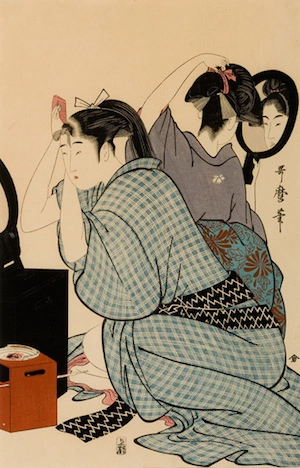
Influence
It is said that James Whistler discovered Japanese prints in a Chinese tearoom nearby London Bridge and that Claude Monet first came upon them used as wrapping paper in a spice shop in Holland.
The influence of Nippon on European art was very different from the influence of other oriental art forms from earlier periods. Previous art pieces from China and other countries were seen as a sort of 'fancy' or fantasy for collectors, not having any true impact on European artists of the time.
In addition, Nippon was secluded for centuries and the appearance of information technology art acquired a new moving ridge of excitement, and as well, artists tried to understand what made Japanese art so unique and were inspired by the works of peachy Japanese artists.
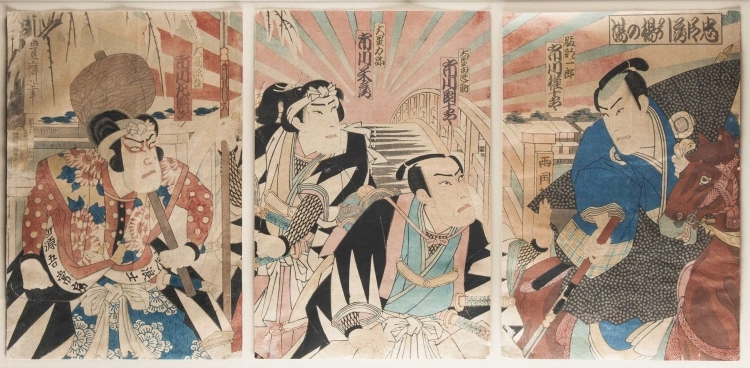
Information technology tin can be found several differences betwixt ukiyo-east and western art from the same period. For instance, woodblock press created an illusion of depth which was practically not-existent in Europeans works of the time.
Ukiyo-eastward had much stronger emphasis on creating dark outlines in the works, due to the fact that the Japanese consider fine handwriting an of import skill by itself and the art of writing is irrevocably continued with Japanese art.
The subject field matter of the ukiyo-e in 18th and 19thursday centuries was fatigued from everyday life, historic the non-heroic, and was based on the idea that all is transient. These prints were mass-produced as woodcuts and were cheap enough for the average Japanese person, or Parisian, to afford.
In this period, the great primary printmakers were Utamaro, Hiroshige and Hokusai.
The fine art of Nihon, in item the ukiyo-e print, was a revelation to Western artists. A stylized, narrative Japanese fine art form that emphasized flowing outlines, stiff sense of pattern and simplified forms. This distinctive way of art flourished in Nippon from the mid-seventeenth to the mid-nineteenth century.
Impressionists and Mail-Impressionists Afterward Ukiyo-e
Impressionism was non only virtually the specific colors and fine art based on empirical analysis and the senses, but mainly about the freedom and rather than a specified motility, it is collection of artists who rebelled against conventional art forms and each of them had their ain unique style; their 'liberty' beingness the most mutual factor which leap them together.
The lack of lines, one of the principles in which impressionism differed from previous styles. The impressionists preferred to use natural brushstrokes, without any lines to border their creative vision, and these strokes appeared to be 'broken' to the unaccustomed eye.
The movement which followed impressionism was post-impressionism. Information technology was mainly a natural answer to impressionism with a higher focus on experimenting with colors in order to attain very personal and sacred image.
Artists stylistically influenced by ukiyo-due east prints include: Edgar Degas, Claude Monet, Vincent van Gogh, Marry Cassatt, Henry de Toulouse-Lautrec, Camille Pissarro, George Seurat, Paul Gauguin, Pierre-Baronial Renoire etc.

The influence of ukiyo-due east tin be seen even inside the works of such a pop painter every bit Vincent van Gogh. He was introduced to ukiyo-east past his brother Theo, when he moved in Paris.
It is believed that he became a collector of Japanese woodblock prints, and as well did some copies; he copies two pieces of eastern woodblock prints, adding his own personal bear on to them. His famous work chosen '' The Courtesan'' (pictured above) is inspired past Japanese fine art.
The painting bears resemblance to the way of woodblock printers, withal it also has Van Gogh's personal fashion characteristics and his typical brushstroke.
Hokusai Katsushika
Hokusai Katsushika was one of the nearly important ukiyo-e artists of Japan who created several volumes of woodblock prints called 'Manga.
Today, the term manga refers to a blazon of Japanese comic books; there is no show pointing to a connection between Hokusai'due south manga and today's comic book fine art – although the first mangas are said to have surfaced in the late nineteenth century, some time after Hokusai's manga was published posthumously.
It is more widely accepted that manga as a comic book form came from American influence which adopted into the Japanese culture.

Hokusai'southward manga series had a wide influence on many French Impressionists and Postal service-Impressionists. Information technology was mainly seen on the prestigious French printmaker Felix Bracquemond, a husband to one of the well-known female artists of impressionism, Marie Bracquemond.
He was intrigued by the representation of nature and encouraged many other artists to report the cracking art from Nihon.
Edgar Degas
Edgar Degas and his friend James Tissot were amidst the primeval collectors of Japanese art in France. Also, their own art was affected by exotic things in very different ways; Unlike Tissot, and others who came nether the spell of Japan, Edgar Degas avoided staging japoneries that featured models dressed in kimonos and the conspicuous brandish of oriental props.
He absorbed qualities of the Japanese aesthetics that he institute most sympathetic: asymmetrical compositions, aeriform perspective, elongated pictorial formats, focus on singularly decorative motifs, spaces emptied of all just abstruse elements of line and colour.
He was fascinated by the delineation of women in manga, every bit he himself focused very ofttimes on ballerinas, dancers and other women in movement. See his piece of work below, "The Trip the light fantastic toe Class". Degas' work also shared similarities with Japanese woodblock prints in the theme of women in day-to-solar day situations.
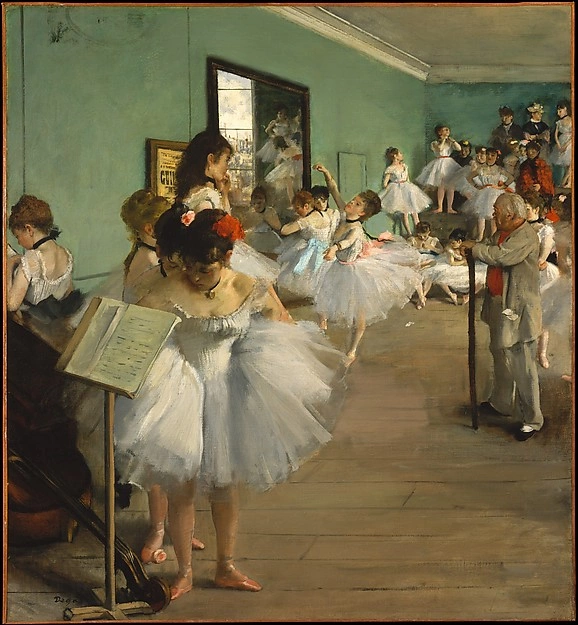
Mary Cassatt
Mary Cassatt, an American artist who lived in Paris, and the one of Degas' close assembly, had ordered and collected many pieces of ukiyo-e, like many of her contemporary colleagues, was intrigued by them.
Afterwards visiting a big exhibition of ukiyo-east prints at the École des Beaux-Arts in Paris, in spring 1890, she produced a gear up of ten color etchings in open admiration of their subjects, technical innovations and compositions.
In Japanese prints, similar those of Utamaro, she found a fresh approach to the description of common events in women's lives.
Amongst the things that fascinated Cassatt were the non-complex compositions from unusual standpoints, the blank spaces between the colors and the simple lines that were able to speak to the observer. She created several print serial using the woodblock printing technique mutual in Japan; she even undertook to adding color to these prints past using several different cake of wood with dissimilar colors spread onto them.
She used these prints to brand her ain experiments with the effects color combinations could accept. Her prints after ukiyo-e, show mainly women in everyday tasks; one of the near prominent works from her series being ''Woman Bathing'' (below).
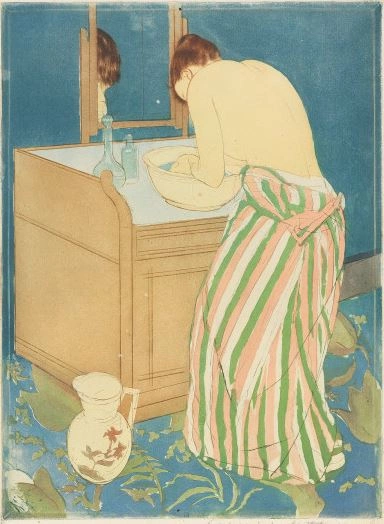
Claude Monet
Claude Monet'south painting '' Madame Monet en costume Japonais'' depicts a European woman in traditional Japanese clothing surrounded by fans. Whether this painting could exist considered his celebration of Asian art or, on the contrary, a mocking image of Paris, obsession with Japanese art at that time, remains a question of contend.
Monet was an avid admirer of Hokusai and had many of his prints in his possession. There is even a speculation that Hokusai's focus on flowers may have inspired Monet to use water lilies as a model for painting.

Paul Gauguin
Paul Gauguin, a notable artist whose works are also placed inside impressionism and mail-impressionism, was known for his vast travels and for his admiration for native and tribal arts of many cultures. Influence of ukiyo-due east on his work is most notable in the absence of shadows, which is a trait that the Japanese woodblocks also share.
Only Paul Gauguin sidestepped the then-current practice of lithography and adopted Japanese woodcut technique to the abstract expression of his forrad-looking art.
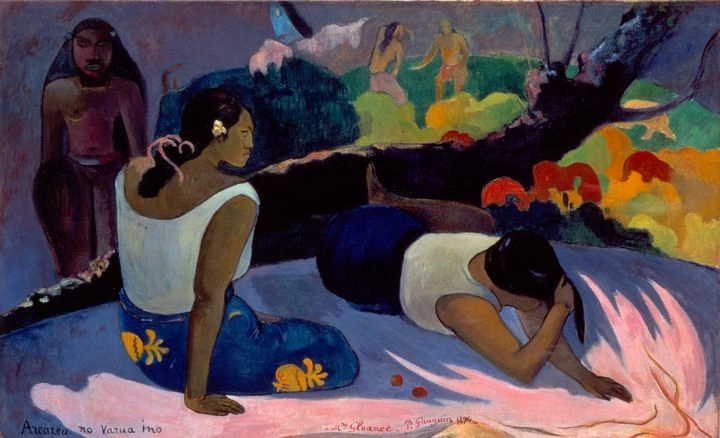
Henri de Toulouse-Lautrec
Henri de Toulouse-Lautrec is also considered to be inspired by ukiyo-due east to some caste. He was known to create commercial course of art, such as posters, just as frequently as effectively works. The influence of ukiyo-e is mainly notable in these commercial works; he borrowed the mode of the prominent Japanese artists, such equally Utamaro, Hokusai and Harunobu, successfully recreating the ''flatness'', yet dynamism of their woodblock prints.
He besides adopted the exaggerated colors, contours and facial expressions found in Kabuki theater prints in club to create his eye-catching posters. Lautrec died at the aforementioned age equally Van Gogh, every bit a outcome of his decadent lifestyle, but he changed the mode people viewed affiche printing and is considered a pioneer and revolutionist of this craft.
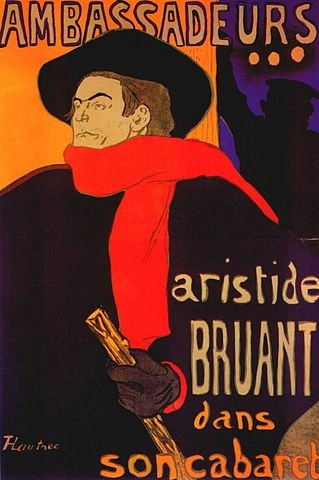
The End Of Isolation
Japan has been a bailiwick of fascination ever since its harbors opened to the rest of the globe. It could exist argued that the end of Nippon's isolation was violent and almost plummeted the land into civil state of war, information technology also showed the world the wonders of Japanese fine art.
In addition, many of the near impressive pieces of European and American fine art were created only because the artists were inspired by what their Japanese counterparts had to offer. Even today, we are still perplexed past what Nippon has to offer.
People enjoy the exotic feel of Japanese fine art, fifty-fifty their modern artists are often sought out by western consumers. In these modern times, many people enjoy Japanese cinematography, music, and their unique form of animated films called Anime.
Japanese civilization and art have integrated themselves into today's cultural consciousness, but they still retain such a caste of exoticism that they fascinate fifty-fifty today's youth who are, very frequently mistakenly, considered past their elders to exist ignorant in the means of art.
It is left to wonder how many people who enjoy the works of impressionist and post-impressionist artist have no thought how their favorite artists were inspired by the art of a secluded and uncommon country.
Source: https://davidcharlesfox.com/japonisme-influence-japanese-art-western-artists/
0 Response to "What Is the Key Difference in the Formal Elements of Japanese Prints and Western Art"
Post a Comment